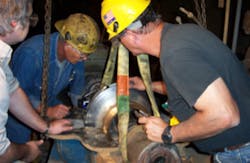(a.k.a. "The Pump Guy")
The Stooges are Larry, Moe and Curly—sometimes Shemp and sometimes Joe. They spend their days getting themselves into, and out of, impossible situations, much like many working mechanics. Most of the time, even they didn’t know exactly what had happened.
When I watch The Three Stooges on TV, I remember my days in the Navy and my two cohorts. My name is Larry, and my mates were Sooty and Joe. Most of the things we did back then served to make me the person I am today in this “Root Cause,” “Six Sigma” world.
The year was 1970. I was a mechanic in the Navy, a lowly Seaman on a pump-improvement team. We were called to a third-tier military base. It had an airstrip for military flights and a few commercial flights each day because it was convenient for the locals.
At the time, I really didn’t understand pumps. I thought I did, but I didn’t. I knew about rebuilding pumps.
Sooty was my superior. He was a 3rd Class Petty Officer. His index finger was paralyzed into a permanent hook. He called it “Lifer’s Cramp.” It was perfect for dangling a coffee cup.
I’m not sure if Sooty was his real name. It might have been “Suity” because when he wasn’t in his Navy dungarees, he wore a variety of leisure suits. But he was a trained boiler technician (meaning he could find the “Reset” button), so his name might have been “Sooty” all the same.
Joe was a university math major when the military draft caught him in ‘68. A Navy recruiter told him he would work with computers if he joined the Navy—Joe believed the recruiter.
Anyway, Sooty, Joe and I were sent to rebuild a large, old split-case pump tasked with moving chill-water in the basement of this military air terminal. Sooty and Joe had done the initial preparation. Sooty isolated the motor, and Joe removed the coupling to the pump shaft.
My specialty was “disappearing for long periods.” (I read my evaluations.) So, when I arrived, the electric chain hoist was in place over the pump. The hooks were tensioned to the lifting points on the top half of the pump casing. We removed the big casing head bolts.
Sooty operated the chain hoist because he was a 3rd Class Petty Officer. Sooty touched the hoist button. The pump’s top casing should have lifted an inch, but it only rose slightly. The casing head gasket had vulcanized to both sides of the casing.
Joe pushed his computer (actually, it was a screwdriver) into the two halves to keep them separated. Everything looked OK. I watched the hoist when Sooty touched the button again. Another inch of chain passed through the hoist, but I didn’t detect any further movement of the top casing.
Joe hit his computer (the screwdriver) with another computer (a hammer) to drive the point between the two casing halves. He said, “Once more and she’ll break free.” He was so right. Sooty pressed the button again, and more chain disappeared into the hoist.
Suddenly something did break free. It was a huge chunk of concrete and a band of steel falling from the ceiling. It might have killed us. Just as we all looked up in wonderment, another loud cracking noise came from above. Then it happened.
Thousands of gallons of warm, slimy liquid rained down on us. It was foul smelling chill-water. I felt like the Egyptian Pharaoh, standing in the middle of the parted Red Sea after Moses had reached the other side and lowered his staff. The waterfall swept us off our feet and we all floated in different directions.
If the pump suffers wear and erosion, you can recover the worn parts with plastic steel. And, you can overcoat the worn area with a few more mils of plastic steel and further extend the life of the part. A mil is .001”. I mean, if a little bit of plastic steel is good, then a little more would be better, right? CERTAINLY!!
Within about 20 seconds, the exploding cascade filled the airport basement with 4 inches of warm water. The electricity and air conditioning went off in the airport. It was 96 F that day. The airport closed and civilian flights were cancelled.
The terminal was built with no overhead crane or rail hoist for heavy lifting. So Joe and Sooty had secured the portable hoist to an overhead chill-water pipe. Rather than lift the pump casing, we had pulled the chill-water pipe and support racks from the ceiling. “Nyuk! Nyuk! Nyuk! I’ll Murdalize Ya!”
Three days later, we finally lifted the top casing on that pump to expose the internals. We kept our heads low as we walked among the HVAC technicians and electricians. They gave us the evil eye and looked at us as though we were stupid.
Sooty, the 3rd Class Petty Officer noted that the pump internals were worn and eroded. He said we’d re-metalize the casing with plastic steel. I had first seen plastic steel when I worked as a mechanic in a steel mill before joining the Navy. “Nyuk! Nyuk!!”
Joe and I mixed and slathered the plastic steel because we were seamen and Sooty was a 3rd Class Petty Officer. We didn’t take any measurements or prep the surface.
(Most mechanics still don’t perform adequate surface preparation today as they slather plastic steel onto a pump part. I witnessed this recently at a chicken processing plant. It delaminated shortly afterward. Times haven’t changed that much.)
We over-coated the wear bands and the pump housing. We let the plastic steel harden and dry. Then we reassembled the pump. After tightening the head bolts with a torque wrench, we noticed that the shaft was binding and wouldn’t spin freely.
"Bluing" indicated that the wear bands were binding and scraping. So Sooty told us to reassemble the pump without the wear bands. I thought to myself, “Sooty is so smart. That’s why he’s a 3rd Class Petty Officer and I’m just a Seaman.” Nyuk! Nyuk!!
The wear bands (some people call them wear rings) on a centrifugal pump govern the pump’s efficiency. The rings aren’t designed to wear and calling them “wear bands” is incorrect. They should actually be called “efficiency bands.”
The wear bands on a pump separate the zones of high and low pressure inside the pump. If the high pressure passes to low pressure inside the pump, then the energy is going around and around inside the pump and not leaving through the discharge nozzle. This is wasted energy and lost efficiency. I didn’t understand any of this in 1970. I thought I did, but I didn’t.
Removing the wear bands probably brought that pump down to 20 percent or 30 percent efficiency. Fortunately, my Navy days were a time when there was energy to burn. This loss would make us all sick with today’s energy costs.
These “Stooge” antics still occur today as you read this article. If you’re going to re-cover a pump with plastic steel, you must do proper surface preparation before applying the epoxy. After the epoxy has dried and hardened, any over-coating must be ground down to original gaps and tolerances.
My four years eventually ended and I was honorably discharged from the Navy in 1971. I never saw Sooty or Joe again. Sooty planned to stay in the Navy as a career. Joe went back to Texas. I used the GI Bill to get my education and continue my study and work with pumps. What did I learn as a “Stooge”?
To this very day, I won’t stand under a hoist or crane until I personally verify that it is properly anchored above. I replace the wear bands on pumps rather than trying to recover the old ones. I measure all surfaces to be re-covered. I always go through an extensive surface preparation. You can’t pay too much attention to this aspect of applying plastic steel. I’ll over-coat the application and then grind or machine the area to correct, original clearance.
To this day I resist being called an expert. Often when speaking before a group, I’ll wear one of my Three Stooges ties (see photo) or my Three Stooges suspenders before the audience. I’m aware that sometimes my hosts think I’m mocking the event, but that’s not the case at all. These things keep me grounded. I’m a “Pump Guy,” not a “Pump Guru.”
Larry Bachus, founder of pump services firm Bachus Company Inc., is a regular contributor to Flow Control magazine. He is a pump consultant, lecturer, and inventor based in Nashville, Tenn. Mr. Bachus is a retired member of ASME and lectures in both English and Spanish. He can be reached at [email protected].





